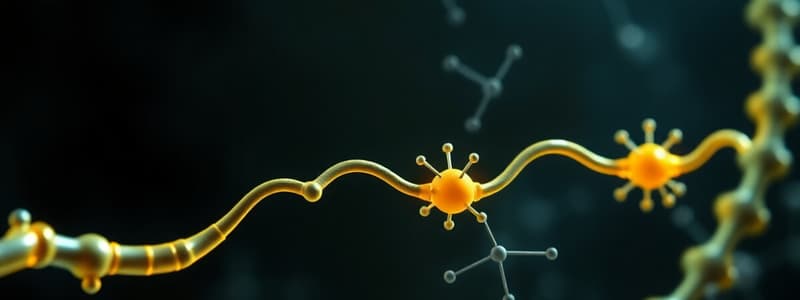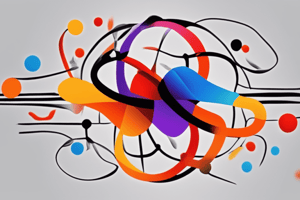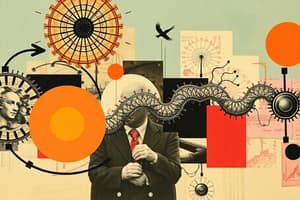Podcast
Questions and Answers
During oxidative phosphorylation, what is the role of reduced coenzymes?
During oxidative phosphorylation, what is the role of reduced coenzymes?
- To add phosphate groups and transfer electrons to the electron transport chain (ETC). (correct)
- To directly accept electrons from oxygen to form water.
- To transfer phosphate groups to ADP.
- To directly synthesize ATP from ADP and inorganic phosphate.
In the Krebs cycle, how many ATP molecules are directly produced per cycle through substrate-level phosphorylation?
In the Krebs cycle, how many ATP molecules are directly produced per cycle through substrate-level phosphorylation?
- 1 ATP (correct)
- 22 ATP
- 2 ATP
- 24 ATP
What is the final electron acceptor in the electron transport chain (ETC)?
What is the final electron acceptor in the electron transport chain (ETC)?
- Cytochrome c
- NADH
- Coenzyme Q
- Oxygen (correct)
Where are the components of the electron transport chain (ETC) located?
Where are the components of the electron transport chain (ETC) located?
What is the main purpose of the electron transport chain (ETC)?
What is the main purpose of the electron transport chain (ETC)?
During the metabolic breakdown of energy-yielding molecules, what is the role of NAD+ and FAD?
During the metabolic breakdown of energy-yielding molecules, what is the role of NAD+ and FAD?
What is a key structural feature of the inner mitochondrial membrane that enhances its function in the electron transport chain?
What is a key structural feature of the inner mitochondrial membrane that enhances its function in the electron transport chain?
What is the function of porin proteins in the outer mitochondrial membrane?
What is the function of porin proteins in the outer mitochondrial membrane?
Where does complex V (ATP synthase) located?
Where does complex V (ATP synthase) located?
Which of the following complexes is not directly involved in pumping protons across the inner mitochondrial membrane?
Which of the following complexes is not directly involved in pumping protons across the inner mitochondrial membrane?
What is the correct order of electron flow through the following components of the electron transport chain?
What is the correct order of electron flow through the following components of the electron transport chain?
What is the role of NADH dehydrogenase (Complex I) in the electron transport chain?
What is the role of NADH dehydrogenase (Complex I) in the electron transport chain?
What is the role of Coenzyme Q in the electron transport chain?
What is the role of Coenzyme Q in the electron transport chain?
Which of the following is a characteristic of Coenzyme Q (CoQ)?
Which of the following is a characteristic of Coenzyme Q (CoQ)?
How do cytochromes contribute to the electron transport chain?
How do cytochromes contribute to the electron transport chain?
In cytochromes, what metal is found in the heme group, and in what oxidation state when it accepts an electron?
In cytochromes, what metal is found in the heme group, and in what oxidation state when it accepts an electron?
What is the effect of rotenone on the electron transport chain (ETC)?
What is the effect of rotenone on the electron transport chain (ETC)?
How does cyanide (CN-) inhibit the electron transport chain (ETC)?
How does cyanide (CN-) inhibit the electron transport chain (ETC)?
How does the electron transport chain contribute to ATP synthesis?
How does the electron transport chain contribute to ATP synthesis?
What is the function of ATP synthase?
What is the function of ATP synthase?
What are the two main domains of ATP synthase, and what is the function of each?
What are the two main domains of ATP synthase, and what is the function of each?
How many protons (H+) must enter the ATP synthase to synthesize one ATP molecule?
How many protons (H+) must enter the ATP synthase to synthesize one ATP molecule?
What happens if the concentration of H+ ions is the same on both sides of the inner mitochondrial membrane?
What happens if the concentration of H+ ions is the same on both sides of the inner mitochondrial membrane?
What is the effect of uncoupling proteins (UCPs) on ATP synthesis?
What is the effect of uncoupling proteins (UCPs) on ATP synthesis?
What is the effect of oligomycin on ATP synthesis?
What is the effect of oligomycin on ATP synthesis?
How does pumping of H+ ions maintain the concentration gradient in mitochondria?
How does pumping of H+ ions maintain the concentration gradient in mitochondria?
What is the approximate P:O ratio for NADH?
What is the approximate P:O ratio for NADH?
Flashcards
What is the ETC?
What is the ETC?
A system of electron transport that uses respiratory O2 to produce ATP (energy).
Purpose of ETC?
Purpose of ETC?
Production of ATP (energy).
Where is ETC located?
Where is ETC located?
Located in the inner mitochondrial membrane.
ETC Characteristics
ETC Characteristics
Signup and view all the flashcards
Why is ETC important?
Why is ETC important?
Signup and view all the flashcards
Inner mitochondrial membrane
Inner mitochondrial membrane
Signup and view all the flashcards
Outer mitochondrial membrane
Outer mitochondrial membrane
Signup and view all the flashcards
Intermembrane space
Intermembrane space
Signup and view all the flashcards
Mitochondrial Matrix
Mitochondrial Matrix
Signup and view all the flashcards
Each Complex
Each Complex
Signup and view all the flashcards
Carrier Function
Carrier Function
Signup and view all the flashcards
Final Electron Combination
Final Electron Combination
Signup and view all the flashcards
Complex I
Complex I
Signup and view all the flashcards
Complex II
Complex II
Signup and view all the flashcards
Complex III function
Complex III function
Signup and view all the flashcards
Coenzyme Q (CoQ)
Coenzyme Q (CoQ)
Signup and view all the flashcards
Cytochromes
Cytochromes
Signup and view all the flashcards
Complex IV function
Complex IV function
Signup and view all the flashcards
Complex I cofactor
Complex I cofactor
Signup and view all the flashcards
What happens when ETC is blocked?
What happens when ETC is blocked?
Signup and view all the flashcards
Rotenone
Rotenone
Signup and view all the flashcards
Antimycin A
Antimycin A
Signup and view all the flashcards
Site-specific inhibitors of ETC
Site-specific inhibitors of ETC
Signup and view all the flashcards
ETC and Proton Transport
ETC and Proton Transport
Signup and view all the flashcards
Complexes acting as proton pump
Complexes acting as proton pump
Signup and view all the flashcards
ATP Synthase Function
ATP Synthase Function
Signup and view all the flashcards
Oligomycin
Oligomycin
Signup and view all the flashcards
7.3kcal/mol
7.3kcal/mol
Signup and view all the flashcards
Study Notes
- The electron transport chain (ETC) is also known as the respiratory chain.
Phosphorylation Types
- At the substrate level, 2 ATP molecules are formed.
- At the oxidative level, 22 ATP molecules are formed.
- In oxidative phosphorylation, a phosphate group is added and electrons are transferred via reduced coenzymes to oxygen in the ETC.
- The net ATP produced by the Krebs cycle is 24 ATP.
Krebs Cycle
- The Krebs cycle ends with oxaloacetate.
- At the end of Krebs cycle, 2 ATP, 6 NADH, and 2 FADH2 are produced.
- NADH yields 3 ATP, and FADH2 yields 2 ATP.
- The net ATP production is 24.
Objectives
- Energy-rich molecules like glucose are metabolized through oxidation-reduction, yielding CO2 and water.
- The electron transport chain releases free energy for ATP synthesis and heat production.
- Reactions in the mitochondria are coupled to oxidative phosphorylation.
Electron Transport Chain
- The ETC is a system of electron transport that uses respiratory O2 to produce ATP (energy).
- Its purpose is ATP (energy) production.
- It resides in the inner mitochondrial membrane.
- It is key final common pathway of metabolism.
- Electrons from food metabolism are transported to O2, the terminal final acceptor of electrons.
- It utilizes the maximum amount of body's oxygen.
Metabolic Breakdown of Energy Conclusion
- Extra info: Carbohydrates transform via oxidation reactions into CO2 and water, donating electrons to NAD + FAD resulting in NADH + FADH "energy – rich reduced form.“
- These coenzymes donate a pair of electrons to specialized sets in the ETC where electrons passing down the ETC lose free energy which is used to move protons from the inner mitrochondrial membrane.
- ATP is then derived from ADP; called oxidative phosphorylation.
Mitochondria
- Mitochondria structures include the outer membrane, inner membrane, cristae, inter-membrane space, and matrix.
Mitochondria Structures
- The outer membrane contains (porin proteins), making it permeable to most ions & small molecules.
- The inter-membrane space sits between the outer and inner membranes.
- The inner membrane constitutes a specialized structure and is rich in proteins, impermeable to most small ions & molecules.
- The cristae serves to greatly increase the surface area of the inner membrane.
- The matrix comprises a gel-like solution inside the mitochondria.
- It contains TCA (tricarboxylic acid) cycle enzymes, fatty acid oxidation enzymes & MtDNA (mitochondria DNA) & mitochondrial ribosomes.
ETC Components Locations
- All elements reside in the inner mitochondrial membrane (IMM), except cytochrome C, which resides in the inter-membrane space.
- Complexes: Complex I, Complex II, Complex III, Complex IV, Complex V.
- Mobile electron carriers include CoQ and cytochrome c.
Organization of Electron Transport Chain
- Each complex receives or donates electrons to mobile carriers.
- Carriers receive electrons from donors, then donate to the next carrier in chain.
- Electrons combine with oxygen and protons to form water.
- Oxygen serves as the final acceptor as a part of the respiratory chain.
ETC Complexes
- Complex I - NADH Dehydrogenase: collects the pair of electrons from NADH and passes them to CoQ.
- Complex I Enzyme transfers 2 electrons from NADH to FMN and reduce it to FMNH2, then transfers electrons to Coenzyme Q which will get converted into CoQH2.
- Complex II -Succinate dehydrogenase: key part of *TCA cycle.
- Complex II transfers electrons to CoQ.
- It is also an enzyme that oxidizes succinate to form fumarate and the 2 electrons formed move from the coenzyme and FADH2 to the iron-sulker protein and Coenzyme Q.
Coenzyme Q (CoQ)
- Also called ubiquinone due to its ubiquitous nature in biological systems.
- It is a non-protein member of the ETC as it transports electrons.
- It is lipid-soluble and mobile.
- Facts: CoQ is a mobile electron carrier and can accept hydrogen atoms from NADH dehydrogenase (Complex I), from succinate dehydrogenase (Complex II), and from other mitochondrial dehydrogenases.
- It transfers electrons to Complex III (cytochrome bc₁) and links flavoprotein dehydrogenases to the cytochrome.
Cytochromes and Complexes
- Cytochromes are carrier molecules in plant and animal cell mitochondria, participating in the stepwise transfer of electrons in oxidation reactions.
- Cytochromes = protein + Heme group.
- When cytochromes receive an electron, Fe3+ is converted to Fe2+ by a reduction reaction.
- When Fe2+ donates an electron to the next carrier, it reoxidizes to Fe3+.
- Cytochromes contain either a Heme group (porphyrin ring + iron in Fe3+ or Ferric state) or hemoglobin (porphyrin ring + iron in Fe2+ or Ferrous form).
- Complex III: cytochrome bc1
- Complex IV: cytochrome a + a3 (also known as cytochrome oxidase)
- Electron flow: Coenzyme Q → complex III → cytochromes C → complex IV
Inhibitors of ETC
- These inhibit the passage of electrons by binding to a component of the chain, which blocks the oxidation or reduction reaction meaning inhibit ATP synthesis.
- In such a case, all electron carriers before the block are fully reduced and all electron carriers after the block are oxidized
- Rotenone: Blocks the ETC between NADH dehydrogenase (Complex I) and CoQ.
- Antimycin A: Blocks the ETC between cytochrome bc1 and cytochrome c.
- CN- "cyanide" /CO: Blocks the ETC between cytochrome a+a3 and O2.
- Hemoglobin has a higher affinity for CO than O2, causing hypoxia when inhaled.
- It also inhibits ETC by blocking Cytochrome a+a3.
ETC and ATP Synthesis
- Electron transfer drives protons out of the matrix to the intermembrane space resulting in a lower PH outside due to increased H+.
- Complexes I, III and IV act as proton pumps.
- This creates a proton gradient across the IMM for ATP synthesis.
ATP Synthase
- Coupling of ETC (green arrow) and ATP synthesis.
- Complex II has no function in pumping H+.
- ATP synthase (Complex V) synthesizes ATP with energy from the proton gradient generated by the electron transport chain.
- ATP synthase is composed of two domains: Fo and F1.
- Fo means membrane spanning domain (it can be inhibited by oligomycin).
- F1 refers to an extra-membranous domain.
Proton Transport
- When 1 H+ ion enters the ATP synthase another H+ ion leaves the ATP synthase moving to the matrix.
- This rotation of the upper part of ATP synthase (Fo) causes conformational changes in the extra-membranous F1 domain.
- This conformational change allows it to bind ADP + Pi and releases ATP.
- When 3 H+ ions enter the matrix space, the energy enables the ATP synthase to synthesize 1 ATP from ADP+P₁.
- When both sides matrix space+ intermembrane space contain the same amount of H+ ions there will be no gradient making no energy for ATP synthesizing.
Mitochondrial Gradient
- Starting with the ETC, 2 electrons are transported from NADH to complex 1, pumping 2 H+ ions to the intermembrane space.
- Next, 2 electrons are transported by ubiquinone from complex 1 to complex 3.
- Cytochrome c takes 1 electron from complex 3 and moves it to complex 4, also coupled with H+ pumping.
- In complex 4, 4 electrons interact with an O2 molecule + 8 H+ ions, forming 2 H₂O molecules and 4 H+ ions are pumped to the intermembrane space
- Pumping of H+ ions creates gradients of electrical charge and pH (more positive charges and lower pH on the outside).
ATP Synthesis Energetics
- Energy required for phosphorylation of ADP to ATP = 7.3kcal/mol
- Energy produced from NADH to 02 pair transport = 52.58 kcal
- Excess heat energy is released or used in reactions.
- NADH ratios are 3:1 (3 ATP per reduced oxygen atom).
- FADH2 ratios are 2:1 (2 ATP per reduced oxygen atom).
Inhibitors of ATP Synthesis
- Remember that Hb has higher affinity for CO than O2, therefore it causes hypoxia when inhaled.
- It inhibits ETC in the Cyto a+a3.
- Oligomycin binds to Fo ATP Synthase domains and closes H+ channels
- Makes a channel for re-entry of protons to the matrix without any ATP production.
- Energy then released as heat!
ATP Synthase
- Coupling of electron transport (green arrow) and ATP synthesis.
- Complex II has no function in pumping H+.
The End
- The test is over
Studying That Suits You
Use AI to generate personalized quizzes and flashcards to suit your learning preferences.




